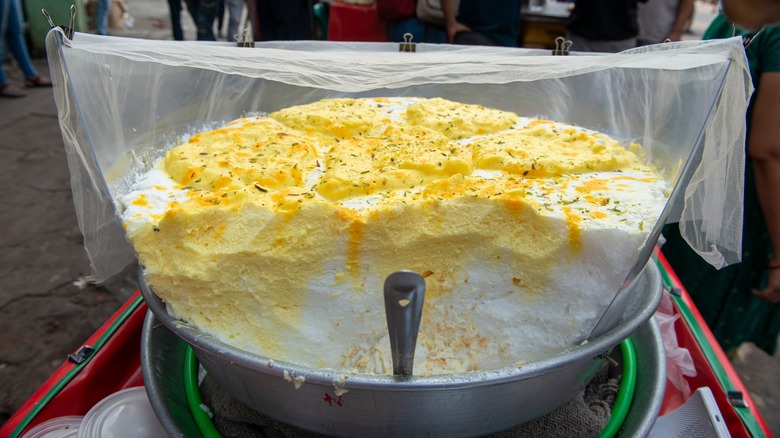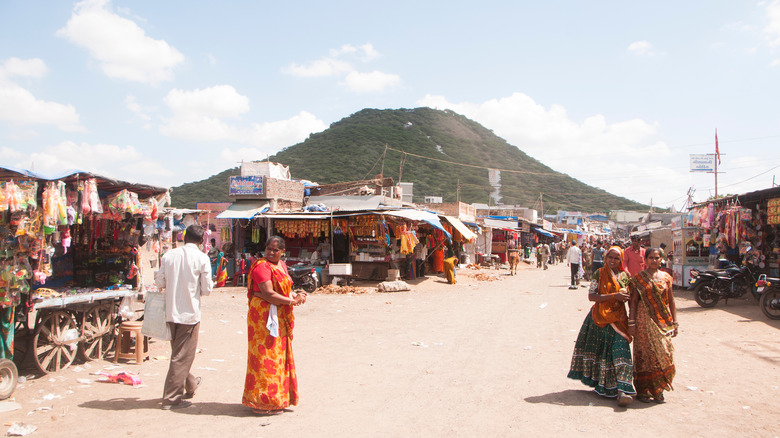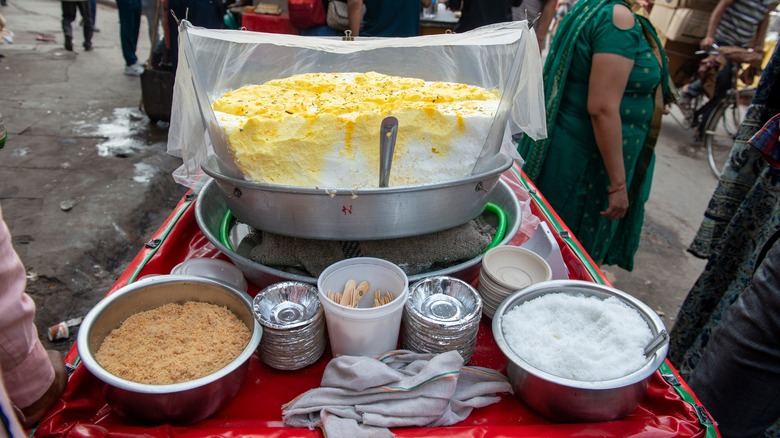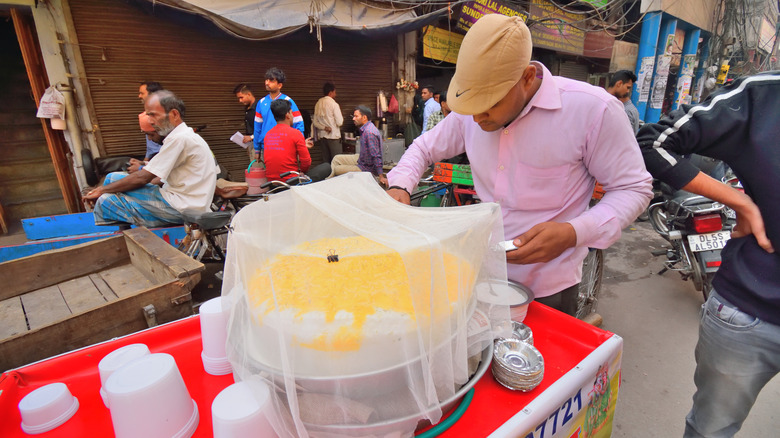The Frozen Indian Dessert Served During Winter
If you're well-versed in the diverse and deeply flavorful world of Indian cuisine, then you may be familiar with some of the country's most delicious desserts. While gulab jamun (fried dough balls) or gajar ka halwa (grated carrots simmered in milk, sugar, ghee, and spices) may currently be competing in your mind for the top spot, there is a lesser known dish, one shrouded in mystery appearing only seldomly in the depth of Indian winter, that may be the true reigning champ of India's dessert world.
The Indian dessert, Daulat ki chaat, is a mystical foamy treat whose texture is airy and whose taste is satisfyingly sweet, according to Food52. The method of creating this traditional treat is a night-long, labor-intensive process that has been passed down for centuries to the skilled street vendors that doll out the dessert today. The dish is wrapped up in heavenly legend and debated origins, giving in an undeniable celestial nature that is worth hopping on a plane to try.
History of Daulat ki chaat
Daulat ki chaat is thought to have originated with Kazakhstan's Botai tribe, per The National News. According to The Better India, the dessert would have made its way to India via the Silk Route and sea traders of the time. However, the site notes that others believe the iconic dish comes from Gujrati traders, meaning traders from the coastal Northwestern state of Gujarat, who prepared the dish in the cold using a unique method. While these are just two of the competing origin stories, the dish is also the source of many legends and myths.
One such legend says that Daulat ki chaat can only be prepared on cold, moonlit nights, as it takes the chilly dew produced from such nights to magically turn a simple bowl of milk into the celestial dessert.
The beginning of the dish's name, Daulat, means "wealth" in Hindi. What this namesake specifically refers to is unknown. Possibly, since the ingredient list includes expensive ingredients like saffron, it was originally made for only wealthy consumers. Or, perhaps, this dessert is just so tasty that consumers can't help but devour it in seconds, possibly like one's wealth. It could also simply allude to the treat being as precious as money, as per The National News.
There is no doubt that these competing ideas and legends shroud the annually-appearing dessert in a cloak of mysticism and wonder. And, it may be fitting for such a magically-tasting dessert.
Ingredients
The main ingredient in today's Daulat ki chaat is milk, the centuries-old version possibly using mare's milk, as per The National News. The modern recipe includes a large amount of milk, cream, cream of tartar, and sugar, which are all mixed together as the base of the dish, as per Food52. The sweet combination, after a long process, becomes enjoyably foamy. Some credit this ideal texture to a winter's night dew.
Food52 cites food writer Madhur Jaffery's book "Climbing The Mango Trees," where the importance of dew is mentioned. The book reads, "Now the most important ingredient is the dew. If there is no dew, the froth will not form. If there is too much dew, that is also bad. The dew you have to leave to the gods." This quote continues to allude to the dessert's mystical connotation and solidifies it as a heavenly treat.
Before serving, the dessert is often topped with quite a few delectable garnishes that elevate the final flavor. It often includes kurchan (thickened milk), chopped pistachios, bora (unrefined sugar), edible silver, and saffron.
How daulat ki chaat is made and when it's eaten
There are only a handful of vendors continuing to turn out Daulat ki chaat using the arduous centuries-old traditional process. According to The National News, the dedicated street vendors start making the dessert the night before by first boiling the milk. Once boiled, cream is added and the mixture is left out to chill in the winter night. Then, at 3 a.m., the milk has to be churned with a wooden stick for about four hours. Eventually, the milk becomes foamy and the top layers are removed and placed in separate pots. After this, the dessert is left out and collects the early morning dew. Before setting out to sell the dish, the foamy dessert is scooped into large trays, set on top of ice, and garnished.
While this authentic version of Daulat ki chaat is made by churning milk for hours through the night, one can also whip up the dessert using electric beaters at home. Thankfully, using the quicker method, you can achieve similar results in much less time, as per Food52.
Daulat ki chaat has historically only been made during the wintertime, being served from fall's Diwali festival to spring's Holi celebrations, per The National News. It is still only available in the country during the winter, usually in bustling marketplaces. But, if you make this magical dessert at home, you can hopefully feel transported to India in no time.



